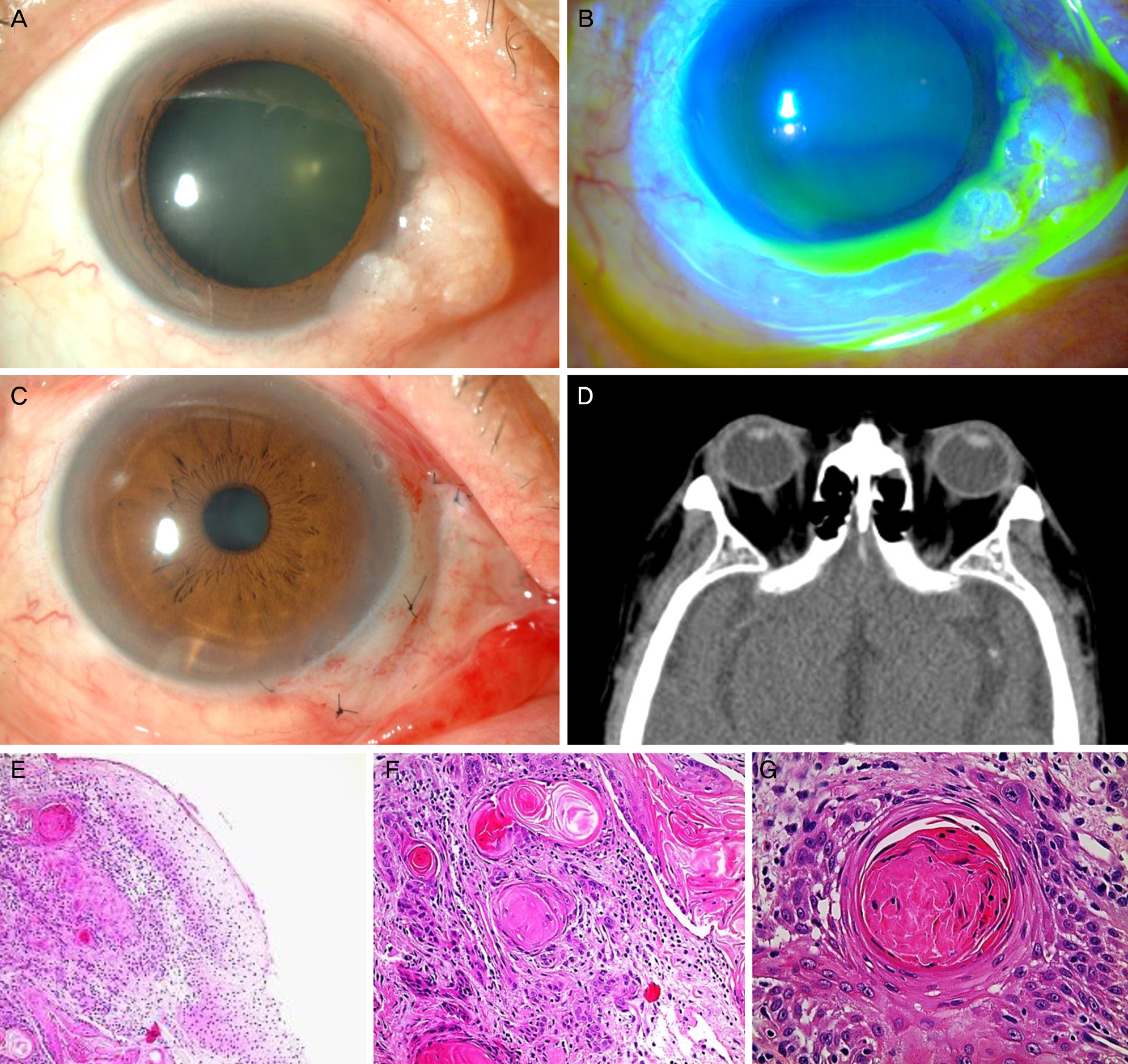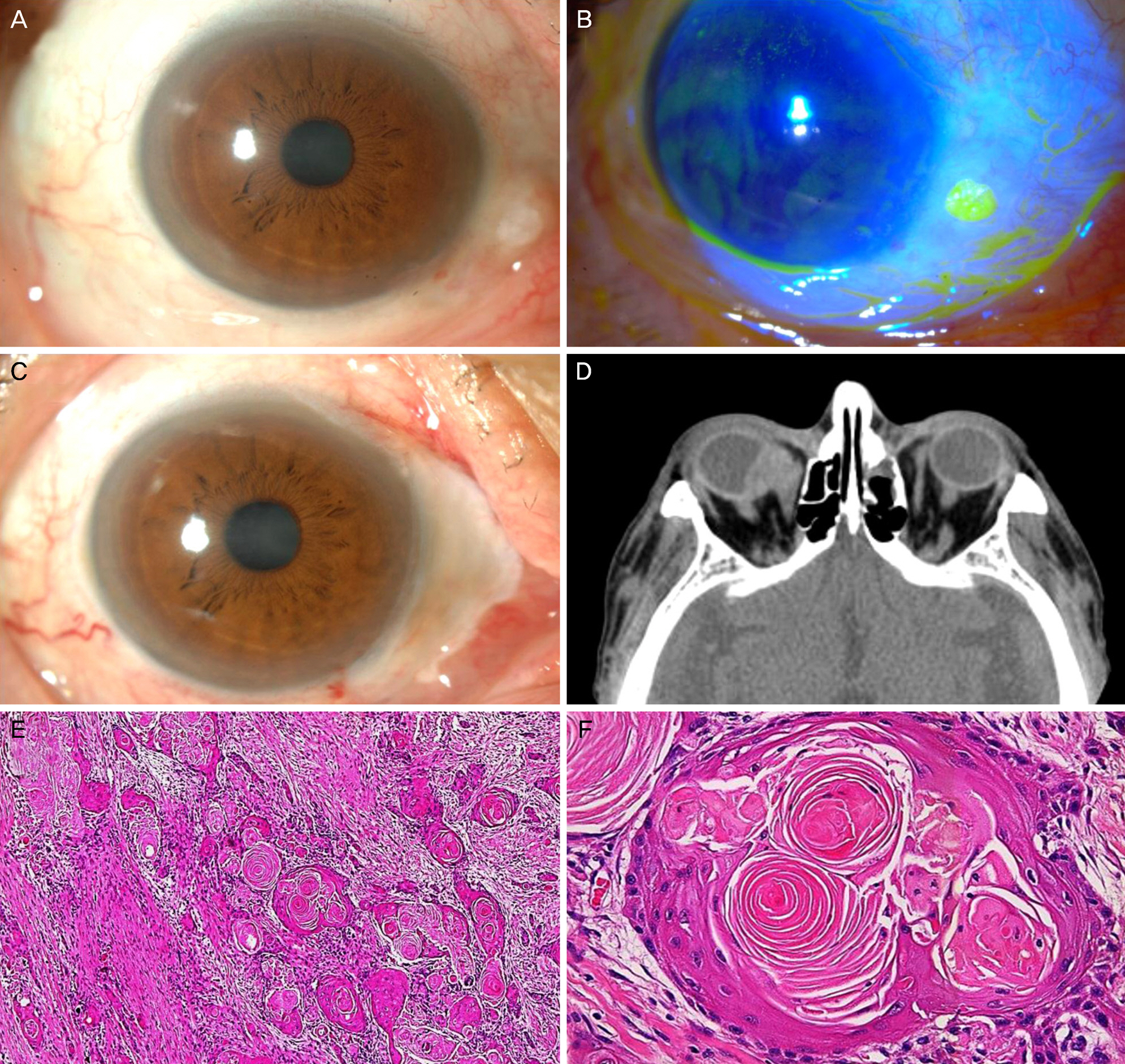J Korean Ophthalmol Soc.
2016 Mar;57(3):507-512. 10.3341/jkos.2016.57.3.507.
Ocular Surface Squamous Cell Carcinoma with Intraorbital Extension in a Patient with Long-Term Immunosuppression
- Affiliations
-
- 1Department of Ophthalmology, Seoul National University Hospital, Seoul National University College of Medicine, Seoul, Korea. bonzoo@medimail.co.kr
- 2Laboratory of Ocular Regenerative Medicine and Immunology, Artificial Eye Center, Clinical Research Institute, Seoul National University Hospital, Seoul, Korea.
- KMID: 2213254
- DOI: http://doi.org/10.3341/jkos.2016.57.3.507
Abstract
- PURPOSE
To report a case of ocular surface squamous cell carcinoma with intraorbital extension in a patient with renal transplantation and long-term immunosuppressive therapy.
CASE SUMMARY
A 59-year-old Korean male presented with a whitish mass in the medial limbus and conjunctiva of the right eye. The patient had undergone renal transplantation 17 years prior due to lupus nephritis and was on systemic immunosuppression with daily prednisolone (10 mg), tacrolimus (5 mg), and mycophenolate sodium (720 mg). The complete excision of the mass was performed and mitomycin C application and amniotic membrane transplantation on the excised area were combined. Histopathological examination revealed the mass was squamous cell carcinoma. There were no abnormal findings on the orbit computed tomography (CT). The patient was additionally treated with topical interferon alpha 2b 6 months postoperatively. One year later, a mass recurred at the same site in the right eye. The complete excision of the mass, mitomycin C application, cryotherapy, and amniotic membrane transplantation were performed. Orbit CT showed a 1.9 cm-sized intraorbital mass involving the medial rectus of the right eye. The orbital exenteration was performed and the intraorbital mass was histologically proven to be squamous cell carcinoma.
CONCLUSIONS
Ocular surface squamous neoplasia in patients with renal transplantation and long-term immunosuppressive therapy should be monitored closely for the possibility of orbital invasion.
Keyword
MeSH Terms
Figure
Reference
-
References
1. Lee GA, Hirst LW. Ocular surface squamous neoplasia. Surv Ophthalmol. 1995; 39:429–50.
Article2. Basti S, Macsai MS. Ocular surface squamous neoplasia: a review. Cornea. 2003; 22:687–704.3. Gichuhi S, Ohnuma S, Sagoo MS, Burton MJ. Pathophysiology of ocular surface squamous neoplasia. Exp Eye Res. 2014; 129:172–82.
Article4. Tsatsos M, Karp CL. Modern management of ocular surface squamous neoplasia. Expert Rev Ophthalmol. 2013; 8:287–95.
Article5. Euvrard S, Kanitakis J, Claudy A. Skin cancers after organ transplantation. N Engl J Med. 2003; 348:1681–91.
Article6. Shields CL, Ramasubramanian A, Mellen PL, Shields JA. Conjunctival squamous cell carcinoma arising in immunosuppressed patients (organ transplant, human immunodeficiency virus infection). Ophthalmology. 2011; 118:2133–7.e1.
Article7. Lindholm A, Ohlman S, Albrechtsen D, et al. The impact of acute rejection episodes on long-term graft function and outcome in 1347 primary renal transplants treated by cyclosporine regimens. Transplantation. 1993; 56:307–15.8. Penn I. Occurrence of cancers in immunosuppressed organ transplant recipients. Clin Transpl. 1998:147–58.9. Penn I. The incidence of malignancies in transplant recipients. Transplant Proc. 1975; 7:323–6.10. Vajdic CM, van Leeuwen MT, McDonald SP, et al. Increased incidence of squamous cell carcinoma of eye after kidney transplantation. J Natl Cancer Inst. 2007; 99:1340–2.
Article11. Porges Y, Groisman GM. Prevalence of HIV with conjunctival squamous cell neoplasia in an African provincial hospital. Cornea. 2003; 22:1–4.
Article12. Goedert JJ, Coté TR. Conjunctival malignant disease with AIDS in USA. Lancet. 1995; 346:257–8.
Article13. Schreiber RD, Old LJ, Smyth MJ. Cancer immunoediting: integrating immunity's roles in cancer suppression and promotion. Science. 2011; 331:1565–70.
Article14. Barrett WL, First MR, Aron BS, Penn I. Clinical course of malignancies in renal transplant recipients. Cancer. 1993; 72:2186–9.
Article15. Penn I. Cancers in renal transplant recipients. Adv Ren Replace Ther. 2000; 7:147–56.
Article
- Full Text Links
- Actions
-
Cited
- CITED
-
- Close
- Share
- Similar articles
-
- Ocular Surface Squamous Neoplasia
- A Case of Squamous Cell Carcinoma Associated With Hydroxyurea Therapy
- Double Primary Squamous Cell Carcinoma on a Psoriasis Patient
- Squamous Cell Carcinoma of the Cervix with Intraepithelial Extension to the Endometrium: A Case Report
- Squamous Cell Carcinomain Renal Transplant Recipient



